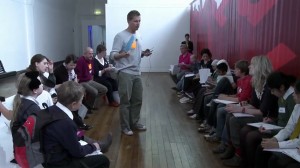
“We also discovered that science is cool and fun because you get to do stuff that no one has ever done before.”
Their paper, based on fieldwork carried out in a local churchyard, describes how bumblebees can learn which flowers to forage from with more flexibility than anyone had thought. It’s the culmination of a project called ‘i, scientist’, designed to get students to actually carry out scientific research themselves. The kids received some support from Beau Lotto, a neuroscientist at UCL, and David Strudwick, Blackawton’s head teacher. But the work is all their own.
The trick was to get the children to see the scientific process as a game – we play by a set of rules to discover hidden patterns and relationships in the world around us. It’s a viewpoint that Lotto firmly believes in and one that turns science education into “a more enlightened and intuitive process of asking questions and devising games to address those questions.” With games on their minds, the children started talking about how animals see the world, using everything from bug-eye lenses to videos of silly dog tricks. The conversation moved onto bees and how they forage for nectar, and the questions came thick and fast.
While the experiments are “modest in scope”, they’re cleverly and correctly designed and carried out with proper controls. They have asked a scientific question and answered it well.
Here is a video about it all.
I Scientist film from Storymakers TV on Vimeo.
There is also a great article about all of this in Discover magazine, click here to read it. Its well worth reading and goes through it all in fascinating detail.
Ah yes, and lets not forget about the actual published research itself. While Biology Letters typically requires a subscription, the Blackawton bees paper will be free until the New Year. I do encourage you to read it as well.